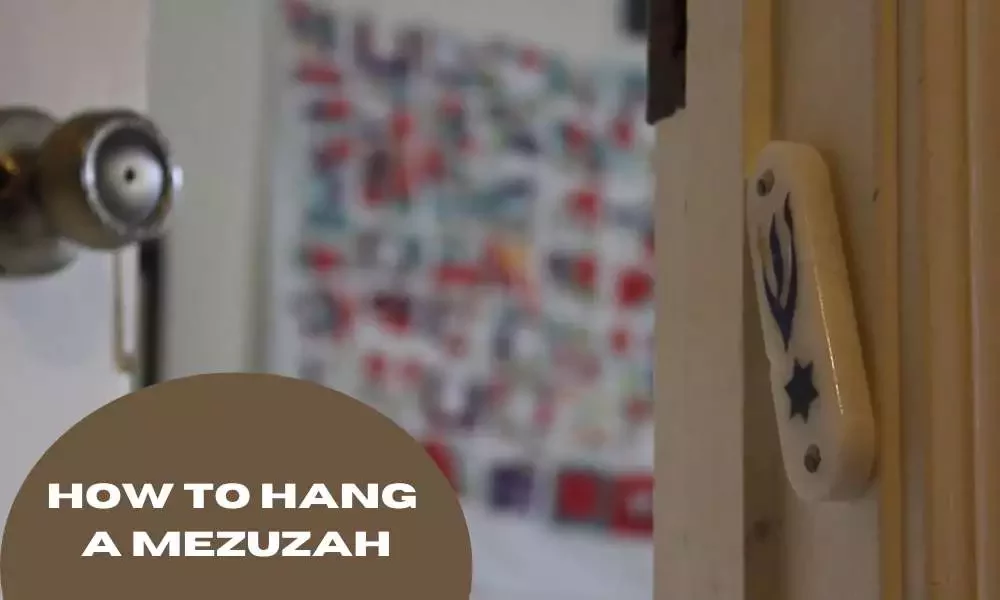Our comprehensive guide will walk you through the proper procedure for hang a Mezuzah. Whether you are new to Jewish customs Or seeking to deepen your understanding of this revered tradition, We aim to provide you with valuable insights and step by step instructions. The Mezuzah holds profound significance beyond its decorative role, serving as a tangible symbol of faith and protection within Jewish homes. In this article, We will explore the precise definition of a Mezuza, Its historical and religious importance, And the profound purpose it serves.
We will then proceed to outline meticulous procedures and guidelines for correctly affixing a Mezuza, ensuring that you can observe this ancient practice with utmost respect and adherence. Join us on this enlightening journey as we explore the proper protocol for honoring and preserving the sacred nature of the Mezuza.
What Is A Mezuzah?
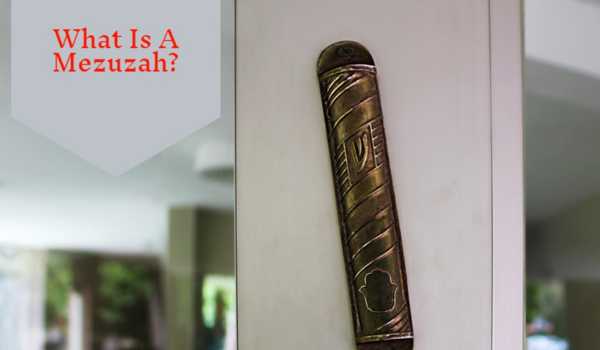
A Mezuzah is a small, rectangular parchment scroll that is inscribed with specific Hebrew verses from the Torah (the Jewish holy scriptures). It is encased in a decorative container and affixed to the doorposts of Jewish homes, typically at a slight angle on the right side of the door as one enters. The scroll contains the Shema, one of the most important prayers in Judaism, which proclaims the oneness of God. The Mezuza serves as a visible reminder of Jewish faith and serves as a symbol of God’s protection and blessings upon the home and its inhabitants. It is considered A mitzvah (commandment) for Jewish individuals to affix A Mezuza to the doorposts of their homes.
Why Hang Mezuzah?

Hanging a Mezuzah holds deep significance and serves multiple purposes within Jewish tradition.
Here are some key reasons why individuals choose to hang a Mezuzah:
Spiritual Connection: Hang a Mezuzah serves as a visible and tangible connection to Jewish faith and identity. It symbolizes A commitment to Jewish heritage, values, And observance of God’s commandments. The presence of a Mezuza on the doorpost reminds individuals of their shared beliefs and their relationship with God, fostering a sense of spiritual connection and grounding.
Divine Protection and Blessings: The Mezuzah is believed to invite divine protection and blessings into the home. The sacred verses inscribed on the Mezuza parchment, including the Shema prayer, are considered powerful expressions of Jewish devotion. By affixing a Mezuza, individuals seek divine guidance, safeguarding, and the benevolent presence of God within their living spaces.
Fulfillment of Mitzvah: Hang A Mezuzah is considered a mitzvah, A religious commandment, in Judaism. It is an opportunity for individuals to fulfill this sacred obligation and express their commitment to Jewish teachings. Observing this commandment is seen as an act of obedience to God’s laws and a way to strengthen one’s connection to Jewish tradition and the broader Jewish community.
Symbol of Jewish Identity: The Mezuza serves as A visual marker Of Jewish identity, not only to those who reside in the home but also to visitors and guests. It communicates a sense of belonging and pride in Jewish heritage, creating a welcoming atmosphere for Jewish observance and celebration.
Continuity and Tradition: Hanging a Mezuza connects individuals to the rich history and continuity of Jewish tradition. It serves as a link between past and present, embodying the customs and rituals practiced by generations of Jewish people. By engaging in this timeless tradition, individuals contribute to the preservation and transmission of Jewish customs to future generations.
Choosing The Location
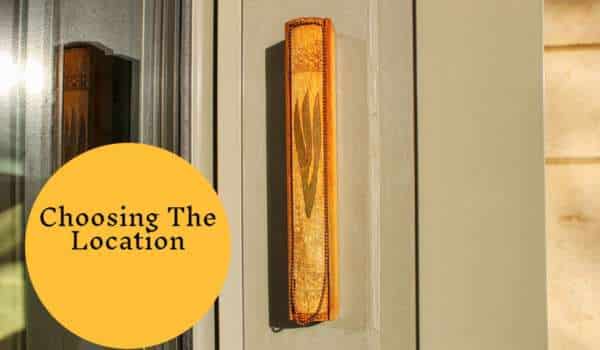
Choosing the proper location for hanging a Mezuza is a crucial step in the process.
Here are some key considerations to keep in mind:
Determining The Doorposts For Placement
The Mezuzah is traditionally placed on the doorpost of the main entrance to a home. In Jewish tradition, this is typically the doorpost of the front door. However, if there are multiple entrances to your home, such as a back door or side entrance that is commonly used, it is customary to affix a Mezuza on those doorposts as well.
Importance Of Selecting A Prominent And Central Location
It is important to select a prominent and central location for the Mezuza. The goal is to ensure that it is easily visible And accessible, Allowing both residents and visitors to see And interact with it. Placing the Mezuza on the right side of the doorpost as you enter is the customary position.
Considerations For Multiple Entrances
If your home has multiple entrances, it is recommended to prioritize the Mezuza placement based on the frequency of use and the importance of the entrance. The front door, which is typically the main entrance, should given priority. However, it is also meaningful to affix Mezuzahs on the doorposts of frequently used entrances to ensure that the entire home is imbued with the blessings and protection associated with the Mezuza.
Gathering the Materials
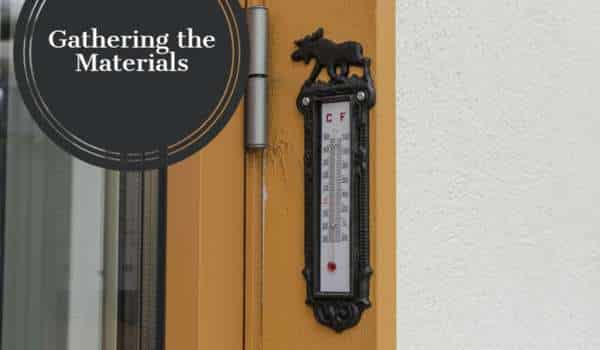
When preparing to hang a Mezuzah, it is essential to gather the necessary materials beforehand.
Here is a list of items you will need:
Mezuzah Scroll (klaf)
The Mezuzah scroll, also known as the Klaf, is a parchment scroll containing specific Hebrew verses from the Torah. It is the central element of the Mezuza. The scroll is carefully handwritten by a scribe and should be obtained from a reputable source to ensure its authenticity and adherence to Jewish legal requirements.
Mezuzah Case
The Mezuzah case is a protective housing for the Mezuza scroll. It can come in various materials, designs, and sizes, allowing for personal preference and aesthetic choices. The case serves to safeguard the delicate parchment and keep it secure. It is important to select a case that appropriately fits the size of your Mezuza scroll.
Parchment Protector (optional)
Some Mezuzah cases come with a transparent parchment protector, also known as a plastic or glass window. This additional layer provides further protection for the klaf, shielding it from dust, humidity, and potential damage while allowing it to be visible.
Appropriate Nail or Adhesive
You will need a suitable nail or adhesive for affixing the Mezuza case to the doorpost. The choice between a nail or adhesive depends on the material and structure of the doorpost. A small brass or metal nail is commonly use for wooden doorposts, while adhesive options such as double-sided tape or removable adhesive strips can use for other surfaces.
Preparing the Mezuzah Scroll
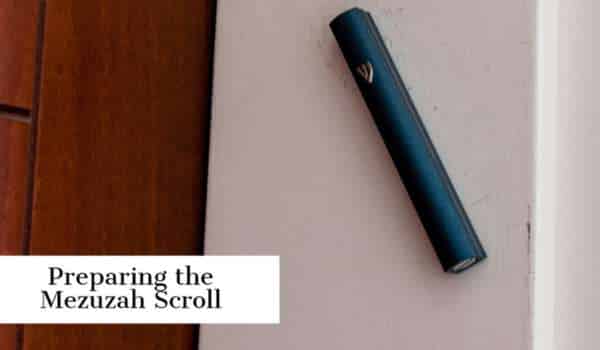
Preparing the Mezuzah scroll is an important step before hang it.
Here are the key actions to take:
Acquiring A Kosher Mezuzah Scroll
It is crucial to obtain a kosher Mezuza scroll from a reliable source. Look for a certified scribe or a reputable Judaica store that specializes in producing or selling Mezuza scrolls. This ensures that the scroll has been written according to strict halachic (Jewish legal) standards.
Checking The Scroll For Defects
Before inserting the Mezuzah scroll into the case, carefully inspect it for any defects or errors. Also, The text should accurately written, with no smudges, missing or faded letters, or other imperfections. If you are not knowledgeable in this area, consult a qualified scribe or an expert who can examine the scroll for its halachic integrity.
Rolling And Inserting The Scroll Into The Case
Once you have verified the scroll’s quality, you can proceed to roll it and insert it into the Mezuzah case. Start by positioning the scroll so that the text is facing inward. Begin rolling the scroll tightly from the left side, ensuring that the text remains on the inside. Carefully insert the rolled scroll into the Mezuza case, ensuring that it fits securely and does not unravel or shift inside.
Mounting the Mezuzah

Using A Nail
1. Choosing An Appropriate Nail
Select a small nail that is suitable for the material of your doorpost. For wooden doorposts, a small brass or metal nail is commonly use. Make sure the nail is long enough to securely hold the Mezuzah case.
2. Measuring And Marking The Placement
Determine the desired height for the Mezuzah and mark the spot on the doorpost using a pencil or light marker. According to Jewish tradition, The Mezuza should placed between one-third and two-thirds Of the doorpost’s height, starting from the bottom.
3. Hammering The Nail Into The Doorpost
Hold the nail at a slight angle and gently tap it into the marked spot on the doorpost using a hammer. Ensure that the nail is firmly and securely anchored in place.
4. Aligning The Mezuzah Case On The Nail
Once the nail is in place, carefully align the Mezuzah case with the nail. Slide the case onto the nail, making sure it is straight and secure. The Mezuzah case should hang with the opening facing toward the room.
Using an adhesive
1. Selecting A Suitable Adhesive
Choose a strong and reliable adhesive that is appropriate for the surface of your doorpost. Double-sided tape or removable adhesive strips are commonly use for this purpose. Ensure that the adhesive is capable of securely holding the Mezuza case.
2. Cleaning And Preparing The Surface
Clean the area of the doorpost where the Mezuza will mounted. Remove any dirt, dust, Or debris to ensure proper adhesion. Dry the surface thoroughly before applying the adhesive.
3. Applying The Adhesive To The Mezuzah Case
Attach the adhesive to the back of the Mezuza case, following the manufacturer’s instructions. Make sure the adhesive is evenly distribute and covers an appropriate area to provide sufficient support.
4. Pressing The Mezuzah Case Onto The Doorpost
Carefully align the Mezuza case with the marked spot on the doorpost and firmly press it against the surface. Apply pressure for a few seconds to ensure a strong bond between the adhesive and the doorpost.
Blessing And Affixing The Mezuzah

Reciting The Appropriate Blessing
Stand facing the Mezuzah and recite the following blessing in Hebrew:
“Baruch atah Adonai Eloheinu, Melech haolam, asher kidshanu b’mitzvotav v’tzivanu likboa mezuzah.”
Translation: “Blessed are You, Lord our God, King of the universe, Who has sanctified us with His commandments and commanded us to affix the mezuza.”
Recite this blessing before affixing the Mezuza to the doorpost. If you are unfamiliar with the Hebrew wording or pronunciation, it is acceptable to recite the blessing in your native language.
Holding The Mezuzah Case In The Correct Position
Take hold of the Mezuzah case, ensuring that the opening faces into the room. The top of the case should pointed diagonally inward toward the home, creating a slight slant.
Affixing The Mezuzah To The Doorpost
Align the Mezuzah case with the designated spot on the doorpost, ensuring that it is positioned straight and at the desired height. Hold the Mezuza case firmly against the doorpost, applying gentle pressure to affix it securely.
Caring for the Mezuzah
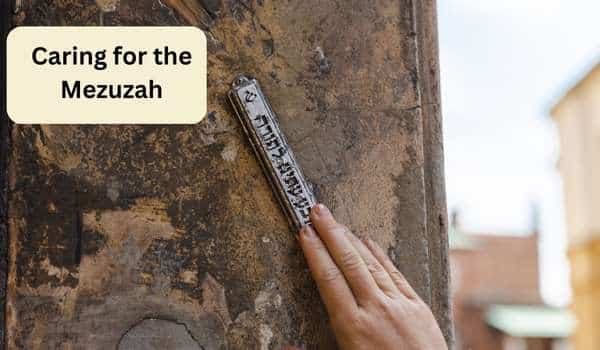
Caring for the Mezuzah is an essential part of maintaining its sanctity and effectiveness. Here are some important practices to ensure the Mezuza remains in good condition.
Regularly Checking The Scroll For Damage
It is recommended to have the Mezuzah scroll checked by a qualified scribe (sofer) every few years, or as advised by your community’s customs. The scribe will carefully inspect the scroll for any signs of wear, fading, or damage that may render it invalid. If any issues are detected, the scroll may need to be repaired or replaced.
Cleaning And Maintaining The Mezuzah Case
Over time, the Mezuzah case may accumulate dust or grime, particularly if it is expose to external elements. To keep the case clean, use a soft cloth or a gentle cleaning solution suitable for the material of the case. Avoid using harsh chemicals or abrasive materials that could damage the case. Regularly wiping and maintaining the case’s appearance helps preserve its aesthetic appeal and keeps the Mezuza presentable.
Protecting The Mezuzah From Environmental Factors
Mezuzahs placed on exterior doorposts are exposed to weather conditions such as rain, sunlight, and extreme temperatures. To prevent damage, consider using a protective parchment cover (klaf protector) inside the Mezuza case. This additional layer helps shield the scroll from humidity, heat, and potential water damage.
Replacing The Mezuzah Scroll When Necessary
If the Mezuzah scroll becomes damaged, faded, or illegible. Also, it is crucial to replace it promptly. An unreadable or damaged scroll does not fulfill the requirements of the mitzvah. Contact a qualified scribe or consult with your local synagogue or Jewish community for assistance in obtaining a new kosher Mezuza scroll.
The Final Thought
Properly hang a Mezuzah is not only a practical act but also carries profound symbolic and spiritual meaning within Jewish tradition. By carefully following the procedures and fulfilling the commandment, you invite blessings and a constant reminder of God’s presence into your home. The Mezuzah serves as a tangible connection to Jewish heritage, representing a spiritual boundary and a symbol of faith.
Caring for the Mezuza, such as regularly checking the scroll for damage, maintaining the case, and replacing the scroll when necessary, ensures its integrity and upholds the sanctity of this important tradition. The Mezuza serves as a constant reminder of Jewish values, teachings, and the commitment to live a life infused with faith and mindfulness. Its presence marks a sacred space, fostering a deeper connection to Jewish identity, tradition, and community.
May the act of hanging a Mezuzah bring blessings, protection, and heightened spiritual awareness to your home. Let it serve as a symbol of faith, A source of inspiration, And A reminder of the Divine presence that accompanies you on your journey.
